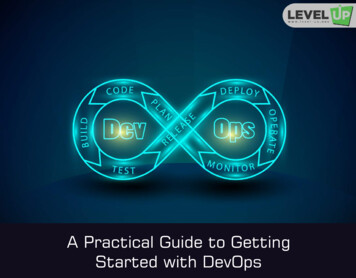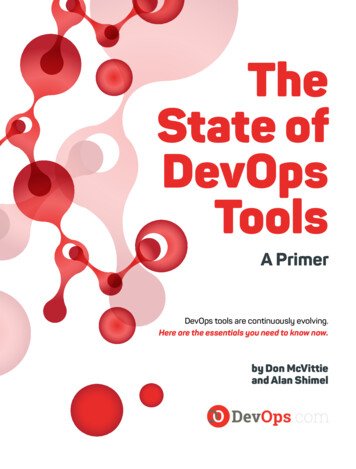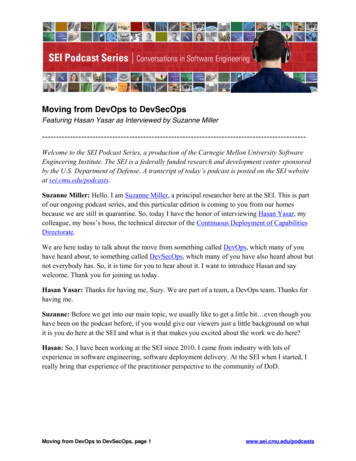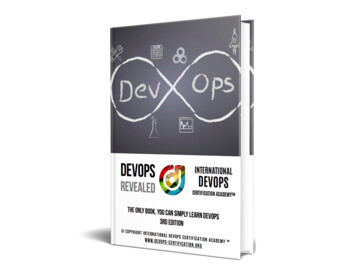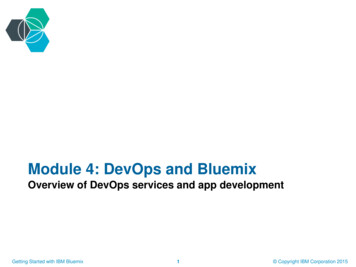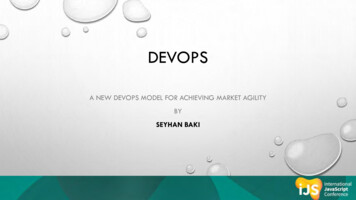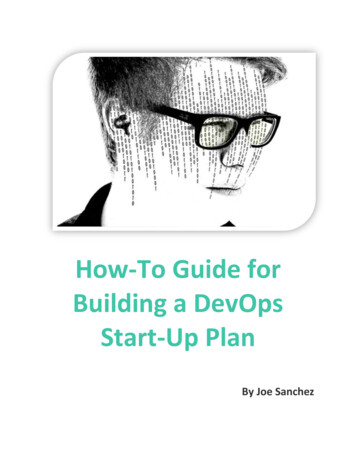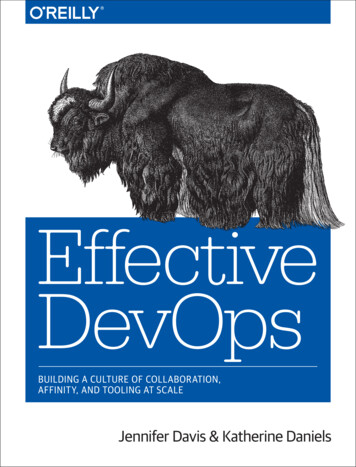
Transcription
SECURINGDEVOPS ATTHE SPEEDOF BUSINESSwww.venafi.com
IntroductionAll DevOps practitionersneed to understand thatthey share importantresponsibilities forsecurity and that it isn’tjust someone else’s job.Continuous improvement and innovation are two fundamental principlesany business needs to stay alive in today’s digital world. The pace atwhich an organization must deliver on these two principles is acceleratinggreatly. Software and information technology (IT) services play an enormousrole in enabling the modern enterprise to create new products, servicecustomers, refine new processes, and develop new business models moreeffectively and efficiently than ever before. This agility is largely the resultof organizations integrating product development with their IT operations,in what has become known as DevOps or Fast IT.This paper discusses how automating DevOps security can acceleratethe pace of innovation. When speed and security coexist in a DevOpsenvironment, organizations can bring products and services to marketfaster than ever before. We also show the benefits of standardizing andautomating the insertion of keys and certificates throughout the process.Plus, we include examples of how automation works with some popularDevOps tools and platforms for built-in security.DevOps Has Arrived and Is Making Its MarkBy adopting a DevOps philosophy, organizations closely align softwaredevelopment with IT operations to optimize product and service deliverythroughout the organization. In practice, this is about reducing time tomarket while maintaining quality and reliability. It is no surprise, then,that DevOps is quickly becoming the de facto model for continuousimprovement and innovation for today’s leading organizations. Accordingly,a global study by CA Technologies found that companies that embraced aDevOps methodology increased their speed to market by 20%, leading toa 22% boost in customer relations and a 19% increase in revenue.1By taking advantage of agile software development methods, ITvirtualization technologies, and new DevOps platforms, such as Chef, Puppet,Docker, and HashiCorp, organizations are able to automate much ofthe process of creating, testing, and releasing new offerings quicklyand inexpensively. But they may do so at a cost: speed often increases therisk of compromised security.DevOps Focuses on Speed, Not SecurityThe challenge many organizations have discovered, however, is that notevery process in this new world of DevOps is fast and automated. Takesecurity as an example. The procurement and provisioning of encryptionkeys and digital certificates required to ensure secure communicationacross the DevOps environment remains largely a slow and manualendeavor that runs counter to the fast DevOps philosophy. Certificatesare essential for protecting pre-production code from attacks, especiallyas it moves across the environment. Certificates also ensure that coderemains protected through its final delivery. Yet, many DevOps teamssimply ignore or sidestep certificates throughout the process.1www.venafi.com CA Technologies. TechInsights Report: What Smart Businesses Know About DevOps. 2013.Page 2 of 8 I SECURING DEVOPS AT THE SPEED OF BUSINESS
When much of theDevOps process isautomated, disruptingthe workflow withmanual certificateprocesses is oftenseen as somethingdevelopers wouldrather avoid.But the speed of DevOps does not have to come at the expense of security.Organizations are finding they can centralize, standardize, and automatethe process of procuring keys and certificates as part of the end-to-endDevOps environment. Automation enables DevOps teams to deliverapplications and IT services more effectively and more securely. But to dothis, DevOps practitioners need to understand that they share importantresponsibilities for security; it isn’t just someone else’s job.Fast IT and Slow ITEstablished companies have an array of legacy applications they maintainto run their business, and not all are well suited to a fast-paced DevOpsenvironment. Many critical tier-one applications, for instance, mustsupport a minimum of five-nines (99.999%) availability, and the notionof continuous upgrades is still too risky for these types of applications.To address this, businesses are creating a bifurcated environment wheretraditional (slow) IT will coexist with the fast and nimble DevOps IT. Gartnerrecommends CIOs heavily promote the mentality of a digital startupwithin their traditional organizations, where one group supports existingapplications that require stability and another (DevOps) delivers “Fast IT”for more innovative projects.2While many CIOs are pursuing such bi-modal IT strategies, current securitypractices for both are still closely aligned with the traditional IT model.Hence, security is often considered an afterthought, when it should bedesigned into the process from the beginning. This is where the intersectionof security and DevOps breaks down because the slow and manual methodof “bolting on” security to applications at the end of the project does notalign well with DevOps, which assumes security is built into the process.Traditional Security is InadequateAdopting traditional security for this new DevOps model has becomesomewhat problematic; in part, because manually procuring andprovisioning keys and certificates is simply too slow. Because the DevOpsprocess is automated, disrupting the workflow with manual certificateprocesses is something developers would rather avoid. In fact, manydevelopers find it easier to ignore certificates to keep security fromdelaying the release.Dismissing or implementing keys and certificates poorly can not onlyexpose the organization to unnecessary security vulnerabilities, butit can also lead to chaos by inserting inconsistent, manual steps intoan increasingly automated environment. Rather, the goal is to providefull control and automated, standardized security over the source coderepositories and the DevOps frameworks developers use every day, sono changes can be made by unauthorized persons.2www.venafi.com Gartner The Four Steps to Manage Risk and Security in Bimodal IT. September 2015. Doc: G00297713Page 3 of 8 I SECURING DEVOPS AT THE SPEED OF BUSINESS
When asked if thespeed of DevOps makesit more difficult to knowwhat is trusted or notin their organizations,79% of CIOs admittedthat it does.The Dangers of DevOps Bypassing SecurityNot maintaining control over the environment can enable attackers to usea compromised, stolen, or forged certificate to impersonate, eavesdrop,and monitor a target’s infrastructure, cloud, or mobile devices and decryptcommunications thought to be private. Misuse of keys and certificates canresult in costly: Data breaches Failed audits Application outages Lack of complianceWhen asked if the speed of DevOps makes it more difficult to know what istrusted or not in their organizations, 79% of CIOs admitted that it does.3 Asthe speed of IT increases with the elastic creation and decommissioning ofservices, keys and certificates will grow in orders of magnitude. Managingthis vast number of keys and certificates at the speed and scale of DevOpswill become even more critical.The use of development containers is increasing. Within the next twoyears, 67% of businesses plan to use them in production environments.Even with this increase in adoption, 60% said they still have securityconcerns.4 Ultimately, developers know they need to maintain a secureenvironment and development process. So why is it that many simply arenot doing it?Building Security into the DevOps ProcessDevOps practitioners have been trained and rewarded for deliveringsoftware updates quickly and continuously and often bring their favoritecoding tools with them. To be effective, security has to work well withthese tools.However, developers are typically not security experts and most donot aim to be. They are less likely to consider anything but the mostbasic security measures to meet their objectives, especially given paststruggles with the error-prone manual nature of certificate provisioning.The result is that security is either ignored completely or minimized tomaintain the velocity of DevOps. The following list represents some of theways DevOps teams get around the proper deployment of certificates: Don’t use TLS/SSL to secure connectionsCreate their own Certificate AuthoritiesCreate self-signed certificatesCreate certificates with weak signature algorithmsMisinterpret or completely ignore security policiesWhile these shortcuts can help developers meet the DevOps imperativeof delivering software faster, they also increase business risks. Ignoringsecurity in DevOps ultimately increases costs by exposing the entireIT infrastructure to expensive data breaches, failed audits, applicationdowntime, and advanced persistent threats (APTs).34www.venafi.com enafi and Vanson Bourne. 2016 CIO Study Results: The Threat to Our Cybersecurity Foundation. 2016.V CSO Online. As Containers Take Off, So Do Security Concerns. September 17, 2015.Page 4 of 8 I SECURING DEVOPS AT THE SPEED OF BUSINESS
Automate Security as Part of DevOpsProvisioning new serversor virtual machines,checking code into andout of repositories andpackaging applicationbuilds have all becomeautomated. So anythingslowing the processruns the risk of beingshortchanged orcompletely ignored.To overcome these issues, organizations must consider the entire processof procuring and provisioning keys and certificates as a fundamental aspectof the DevOps environment. The Venafi Trust Protection Platform helpsorganizations standardize and automate the process and insert theseactivities directly into their existing DevOps workflows. The Venafi APIallows organizations to not only make use of their existing workflowsand processes, it also provides the flexibility to integrate into any DevOpsplatform, such as Chef, Ansible, Puppet, Docker, HashiCorp, and more.Moreover, Venafi allows users to continue using the Certificate Authorities(CAs) of their choice.The Venafi Trust Protection Platform is designed to work within existingenvironments as a fully-automated certificate service, so developmentteams can focus on delivering new applications and IT services quicklywithout security hampering their efforts. Venafi can accelerate thedevelopment process by reducing the time it takes to procure and provisioncertificates from days to minutes through automation.Security teams can centrally define policies through the Venafi API andenable DevOps to properly comply with security policies and best practicesby building in security from the beginning. The Venafi Trust ProtectionPlatform provides the following benefits: Generates and issues unique keys and certificates on demand, usually in secondsExtends the certificate management platform used by security teamsand system administrators to DevOpsProvides a single view of security posture and compliance withintegration to Help Desk systems and SIM/SIEM environmentsAutomates certificate remediation and re-enrollment to align with policiesAutomates alerts based on certificate anomalies detected inside anorganization and across the internetDelivers virtually infinite scalability without additional administrativeoverheadUse Case—Integration with Chef FrameworkDevOps relies on standardization, automation, and close collaborationacross teams to deliver IT services quickly, and developers expect thecertificate process to fit into this paradigm. Provisioning new servers orvirtual machines, checking code into and out of repositories, andpackaging application builds have all become automated. In this fastpaced environment, anything slowing the process runs the risk of beingshortchanged or completely ignored.Venafi removes this traditional bottleneck in the DevOps process byintegrating with DevOps platforms to automate the issuance of keyswww.venafi.comPage 5 of 8 I SECURING DEVOPS AT THE SPEED OF BUSINESS
and certificates directly with the various DevOps platforms. Plus, Venafiprovides sample cookbooks for Chef and other platforms that can be usedto get started quickly.Venafi can actuallyaccelerate thedevelopment processby reducing the time ittakes to procure andprovision certificatesfrom days to minutesthrough automation.The information below provides an example of how the Venafi API can beused to integrate the certificate process into a new or existing Chef framework.1. A Venafi Cookbook is created and tested on the Chef-Repo. If required,it can then be synchronized to the source control system2. T he Chef Knife command-line tool can then be used to push the VenafiCookbook to the Chef Server3. The Chef-Client is used to access the recipes within the Venafi Cookbook.The Venafi Cookbook sample recipes currently include: request newcertificate, check certificate status, retrieve certificate, and revokecertificate4. T he Venafi Cookbook recipes use HTTPS to connect, authenticate, anddirectly consume the available Venafi services (e.g., request, receive,revoke certificate)CHEF SERVERNODESVenafi Aperture DashboardChef-ClientpolicyAPIChef-Clientnode objectVenafi Serviceinternal CAChef-Clientcookbooksexternal CAWORKSTATIONSVenafi CookbookChef-ReposettingsVenafi Integration with Chefsource controlknifecookbookswww.venafi.comPage 6 of 8 I SECURING DEVOPS AT THE SPEED OF BUSINESS
Venafi Trust ProtectionPlatform injects keysand certificates intoDocker containersusing the Docker eventssubsystem and API.Use Case—Integration with Docker ContainersFor Docker, Venafi automatically injects keys and certificates into Dockercontainers as part of the container lifecycle.Microservices and container-based applications are often loosely coupledand not configured to communicate securely. In an environment that’smoving so fast, it’s imperative that applications are properly secured—like any other service with Transport Layer Security (TLS) authenticationand encryption.The example below shows at a high level how the Venafi Trust ProtectionPlatform injects keys and certificates into Docker containers usingthe Docker events subsystem and API. A customer-provided daemon(background process) subscribes to the Docker event stream. For thissimple example, the daemon registers for notifications of container “start”and “terminate” events. When a start event is detected, the followingprocess is initiated:1. The container name is retrieved2. T he Venafi API is used to lookup and retrieve the details of thepre-defined certificate policy3. A new private key is generated and held in memory4. A new certificate signing request (CSR) is created using the Venafipolicy details retrieved in Step 25. The CSR is submitted to Venafi using the name retrieved in Step 16. The process waits briefly, then checks the certificate status withthe Venafi platform.7. When ready, the certificate is retrieved and combined with the privatekey currently held in memory8. The key and certificate are archived and injected directly into thecontainer using the Docker API9. If required, the Docker Exec command is used to start or restart anyservices that depend on the key and certificateConversely, when a container is terminated, the following process is initiated:1. The container name is retrieved2. A certificate revocation request is made to the Venafi API3. Venafi relays the revocation request to the Certificate Authorityconfigured within the policy to revoke the certificatewww.venafi.comPage 7 of 8 I SECURING DEVOPS AT THE SPEED OF BUSINESS
docker host 1dockerremote APIevent-monitorSTARTTERMINATEdockercommanddocker daemoncontainer START: rconequtainester TnewERMcerINAtificTE:aterevoke certificatedockerremote APIVenafi Aperture DashboardAPIdocker Venafi Integration withDocker Events APIcontainer START: request new certificateVenafi Servicecontainer TERMINATE: revoke certificatedocker daemoninternal CAdocker containersexternal CAdocker host 2ConclusionABOUT VENAFIVenafi is the market-leadingcybersecurity company that securesand protects keys and certificatesso they can’t be used by bad guysin attacks. Venafi provides theImmune System for the Internet ,constantly assessing which keys andcertificates are trusted, protectingthose that should be trusted, andfixing or blocking those that are not. 2016 Venafi, Inc. All rights reserved. Venafi andthe Venafi logo are trademarks of Venafi, Inc.Part Number: 160525-WP-DevOpswww.venafi.comAutomating security throughout the process can enable DevOps tomaintain speed and ensure security throughout the environment. Ifyour organization is still relying on manual processes for procuring andprovisioning keys and certificates, chances are it’s either not getting doneor is being done poorly. The risk of inadequate security is exposing yourorganization to costly data breaches, critical application disruptions, dataloss, and failed compliance audits.But it doesn’t have to be this way. The Venafi Trust Protection Platform canstandardize and automate the issuance of keys and certificates within yourexisting DevOps environment—Venafi API integrates with configurationmanagement and container platforms like Chef, Puppet, Ansible, Docker,and more. Stop sacrificing security: your DevOps teams can deliver IT servicesquickly and cheaply while adhering to your key and certificate policies.NOTE: The use cases depicted here are intended to provide high-level examples of howVenafi APIs can be used by security teams to provide key and certificate services to DevOpsteams. Since most of the components fall outside the Venafi domain, the solution has notbeen subjected to any security validation, screening, or ratification by Venafi.Page 8 of 8 I SECURING DEVOPS AT THE SPEED OF BUSINESS
www.veafo Page 6 of 8 I SECURING DEVOPS AT THE SPEED OF BUSINESS Venafi can actually accelerate the development process by reducing the time it takes to procure and provision certificates from days to minutes through automation. Venafi Cookbook policy NODES Chef-Client Chef-Client Chef-Client Chef-Repo knife WORKSTATIONS node object cookbooks .



